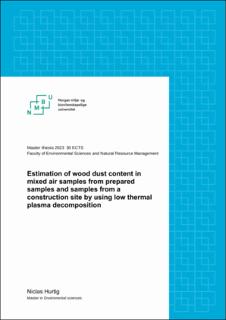| dc.contributor.advisor | Pål Graff | |
| dc.contributor.advisor | Torunn Kringlen Ervik | |
| dc.contributor.author | Hurtig, Niclas | |
| dc.date.accessioned | 2023-07-06T16:29:05Z | |
| dc.date.available | 2023-07-06T16:29:05Z | |
| dc.date.issued | 2023 | |
| dc.identifier | no.nmbu:wiseflow:6839575:54592302 | |
| dc.identifier.uri | https://hdl.handle.net/11250/3076816 | |
| dc.description.abstract | En lav temperatur plasma gravimetrisk metode ble brukt for bedre bestemme trestøv i respirabelt og totalt støv prøver. Testprøver (n=37) for totalt støv ble tillaget ved å samle støv med kombinasjonene av kun tre (n=12), tre og gips (n=9), tre og kvarts (n=6) og tre, kvarts og gips (n=10) støv på PVC-fiberfiltre. Den gjennomsnittlige forskjellen mellom målt og belastet mengde med trestøv var 88-236,1 %. Filtre med tre og tre og kvarts hadde de laveste forskjellene mellom belastet og målt tre støv etter dekomponering. De største forskjellene ble observert i kombinasjonene med tre og gips og tre, gips og kvarts.
Prøver for totalt støv (n=20) og respirabelt støv (n=20) ble innsamlet i løpet av to dager fra en byggeplass der rehabilitering ble utført. Lav temperatur plasma gravimetriske metoden ble benyttet på prøvene. For totalt støv ble trestøvfraksjonen estimert til å utgjøre i gjennomsnitt 19 % av det innsamlede partikulære materialet. For det respirable støvet var innholdet av trestøv i gjennomsnitt 10 %. 10 respirable støvprøver ble analysert med røntgendiffraksjon (XRD) for α-kvarts, α-kvartsen var til stede på alle filtrene og utgjorde i gjennomsnitt 4,5 % av den uorganiske massen. I den analyserte respirable støvfraksjonen ble α-kvartsen beregnet til å være mellom 0,009 – 0,032 mg/m3. XRD med Rietveld-metoden ble brukt på 10 totale støvprøver som en komplementær tilnærming for å forklare sammensetningen av den uorganiske fraksjonen. Medianandelen av mineralstøvet inneholdt kalsitt, kvarts og feltspat, disse utgjorde 92 % av den uorganiske resten. Andelen mineralstøv på individuelle filtrene varierte. Korreksjon av massetap etter dekomponering, ble α-kvarts beregnet til være 0,1 mg/m3, kalsitt 0,49 mg/m3 og feltspat 0,19 mg/m3.
Resultatene fra byggeplassen indikerte at bruk av denne metoden var en bedre tilnærming, enn kun gravimetrisk bestemmelse av total og respirable konsentrasjonene etter prøvetaking. Uten metoden benyttet i dette arbeidet ville trestøveksponeringen blitt overvurdert. Videre indikerte det at trestøv ikke er den største bidragsyteren til PM på byggeplasser der rehabilitering pågår, og at uorganiske rester er den største bidragsyteren til eksponering for arbeidere. | |
| dc.description.abstract | A low thermal plasma gravimetric method was used to increase accuracy when measuring wood dust in respirable and total dust. Test samples (n= 37) for total dust were prepared by collecting dust with the combinations of only wood (n=12), wood and gypsum (n=9), wood and quartz (n=6) and wood, quartz, and gypsum (n=10) dust onto PVC fibre filters. The average difference between the measured and loaded mass of wood was in the range of 88-236,1 %. Filters with wood and wood and quartz had the lowest difference between loaded and measured wood after decomposition. The largest differences were observed in the combinations wood and gypsum and wood, gypsum and quartz.
Total dust (n=20) and respirable dust (n=20) was collected during two days from one construction site where rehabilitation was undertaken. The low thermal plasma gravimetric method was applied to the samples. The workplace wood dust results averaged at 19 % for total dust. For the respirable dust, the wood dust content averaged at 10%. 10 respirable dust samples were analyzed with x-ray diffraction (XRD) for α-quartz. The α-quartz were present at all the filters and accounted for an average of 4,5 % of the residue mass. In the respirable dust fraction analyzed, the α-quartz was estimated to be between 0,009 – 0,032 mg/m3. XRD with the Rietveld method was applied to 10 total dust samples as a complimentary approach to explain the composition of the remaining total dust. The median proportion of the mineral dust contained calcite, quartz, and feldspar, these accounted for 92% of the inorganic residue. The proportion of mineral dust on individual filters varied. Correction of mass loss after decomposition, the estimated content in the air was on average for α-quartz 0,1 mg/m3, for calcite at 0,49 mg/m3 and feldspar at 0,19 mg/m3.
The results from the construction site indicated that the application of this method would be a better approach, than only relying on the total and respirable concentrations alone after sampling. Without the method used in this work, the wood dust exposure would have been overestimated. Furthermore, it indicated that wood dust is not the biggest contributor to particulate matter at construction sites where rehabilitation is being undertaken and that inorganic residue is the largest contributor for exposure to workers. | |
| dc.language | eng | |
| dc.publisher | Norwegian University of Life Sciences | |
| dc.title | Estimation of wood dust content in mixed air samples from prepared samples and samples from a construction site by using low thermal plasma decomposition | |
| dc.type | Master thesis | |
